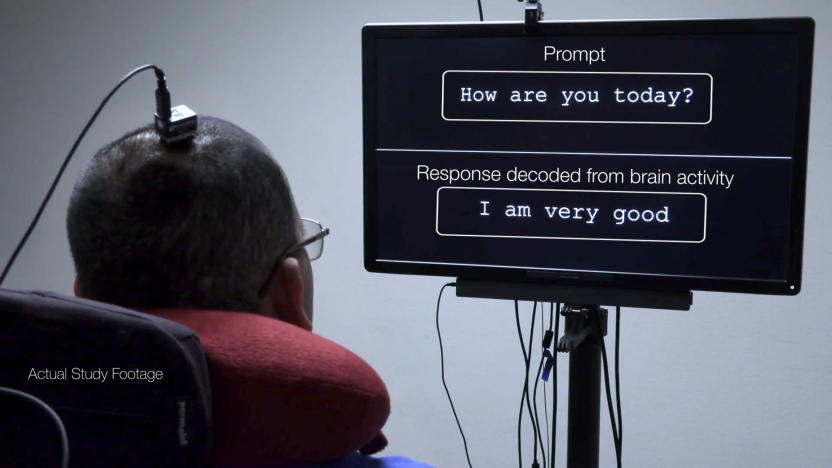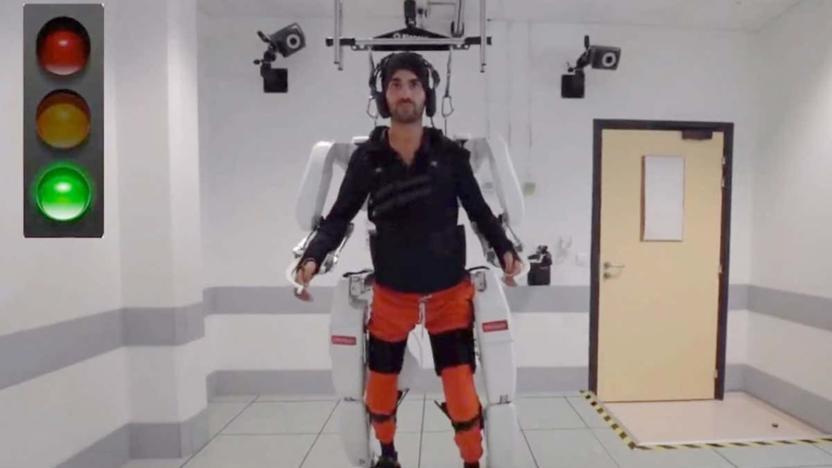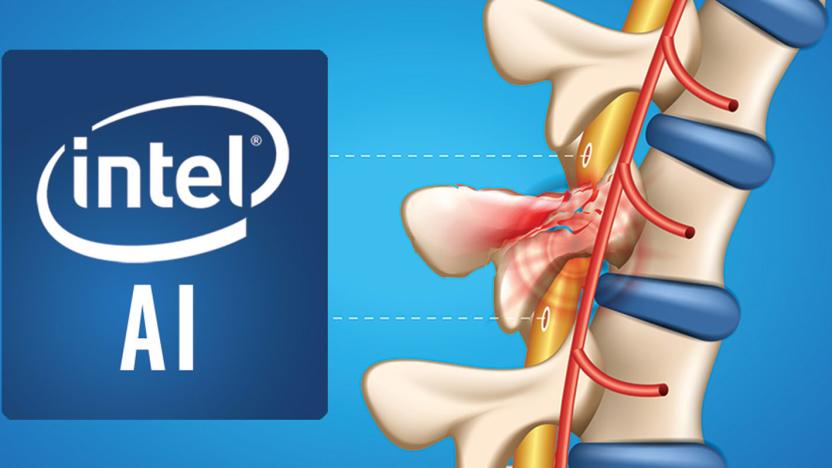paralyzed
Latest

Severely paralyzed man communicates using brain signals sent to his vocal tract
A severely paralyzed man communicated using a system that translates signals from his brain to his vocal tract directly into words that appear on a screen.

A mind-controlled exoskeleton helped a paralyzed man walk again
A paralyzed man regained the ability to walk with the help of a robotic exoskeleton that he controlled with his mind. Unlike other, more invasive mind-controlled robotics, this one used electrodes implanted above the brain's outer membrane, not in the brain itself. That could reduce the risk of infection and other obstacles that have limited the success of mind-controlled robotics.

Intel wants to use AI to reconnect damaged spinal nerves
AI's use in medicine could soon extend to one of the medical world's toughest challenges: helping the paralyzed regain movement. Intel and Brown University have started work on a DARPA-backed Intelligent Spine Interface project that would use AI to restore movement and bladder control for those with serious spinal cord injuries. The two-year effort will have scientists capture motor and sensory signals from the spinal cord, while surgeons will implant electrodes on both ends of an injury to create an "intelligent bypass." From there, neural networks running on Intel tools will (hopefully) learn how to communicate motor commands through the bypass and restore functions lost to severed nerves.

Paralyzed man first to move his arm by thinking about it
Helping paralyzed people move on their own has been a lot tougher than 1970s TV shows led us to believe it would be. For what they believe is the first time, researchers used tech to bypass a quadriplegic patient's severed spinal cord, helping him move his own hand with his mind and feed himself without aid. The work could lead to "a new generation of neurotechnologies that we all hope will one day restore mobility and independence for people with paralysis," says research lead Leigh Hocherg.

ICYMI: The alcohol creating energy and removing pollution
try{document.getElementById("aol-cms-player-1").style.display="none";}catch(e){}Today on In Case You Missed It: The University of Colorado, Boulder is diving into a beer project with a surprising twist: Researchers have managed to use beer brewing runoff to grow a species of fungus that not only cleans the water but can also be used to create lithium-ion batteries. Meanwhile the University of Pittsburgh Medical Center is helping paralyzed people regain a sense of touch through a robotic arm, by implanting electrodes in the participant's brain. The flexible phone display for music is here, and the BMW concept motorcycle that had everyone talking is here. In case you're friends with someone on Tinder, they should know about this story. As always, please share any interesting tech or science videos you find by using the #ICYMI hashtag on Twitter for @mskerryd.

ICYMI: Temporary tat yourself for user interface
try{document.getElementById("aol-cms-player-1").style.display="none";}catch(e){}Today on In Case You Missed It: Microsoft and MIT built a computer interface that drops a touchpad into a shiny, golden temporary tattoo. Just as fantastic as you'd imagine, people can use them to input commands, get notifications and store data like NFC tags.

Eye-tracking app lets you make music hands-free
Eye- and face-tracking systems already help you communicate when your hands aren't an option, but what if you want to have some fun? You're covered there, too. Andreas Refsgaard has built Eye Conductor, an app designed to help the paralyzed (and virtually anyone else) make music. All you need is a computer, an off-the-shelf eye tracker and a willingness to look slightly goofy as you twitch your eyes and open your mouth. Unlike some previous attempts, it's all about having an accessible, flexible interface -- you know exactly what sounds you'll make, whether it's an experimental piece or a slick dance track.

Brain implants help the paralyzed type faster
It's possible for paralysis victims to type and otherwise communicate with the world, but they usually have to do so at a glacial pace. They might not be nearly so limited in the future, though. In experiments combining BrainGate2 (a high-speed neural implant system) with text entry software, researchers had a Lou Gehrig's sufferer type words at six words per minute. While that may not sound quick on the surface, it's incredibly fast for someone relying solely on mental activity to write a message.

For the first time, a paraplegic has walked without a robotic suit
A paraplegic has walked without robotics using his own brain waves, thanks to research done at Southern California's UC Irvine. Scientists used a computer to "link" 28-year-old Adam Fritz's brain to his legs over a Bluetooth connection, bypassing the severed region of his spinal cord. An EEG then picked up signals from his brain, which were relayed by a "brain-control interface" (BCI) computer to electrodes on his knee, triggering walking movements. Though Fritz was supported and only walked haltingly for 12 feet, the research is being heralded as a milestone -- so far, paralyzed patients have only be able to walk using suits like that from Ekso Bionics.

Eye tracking will help the paralyzed talk to the outside world
Those affected by locked-in syndrome are effectively cut off from the outside world. They're paralyzed to the point where they can't move or speak -- in many cases, they might only have control over their eyes. Thankfully, technology might just use that remaining freedom to give these sufferers a voice. UC San Diego researchers are developing systems that use eye tracking for communication. One prototype, EyeHome, would have you navigating a phone-like interface by gazing at different parts of the screen. You'd look one way to dictate a message, or another to catch up on social networks. Other elements could include specialized e-book readers and even eye-guided musical instruments.

Flexible spinal cord implants will let paralyzed people walk
Doctors dream of helping the paralzyed walk through implants that stimulate their spinal cords, but current technology makes that impossible; these stiff, unnatural gadgets usually end up damaging or inflaming nervous tissue over time. Swiss researchers may have just solved this problem once and for all, though. Their bendy e-Dura implant combines flexible electrodes (made of platinum and silicon microbeads), cracked gold electronic tracks and fluidic microchannels to deliver both electrical impulses and chemicals while mimicking the spine's movements and avoiding friction. Paralyzed rats in lab tests could both walk again after a few weeks and keep wearing their implants after two months.

Paralyzed teen to kick World Cup's first ball with mind-controlled exoskeleton
This year's World Cup could be host to something more exciting than a bicycle kick scoring the winning goal. Thanks to an international collaboration between universities such as Colorado State University, the Technical University of Munich and the Lily Safra International Institute of Neuroscience of Natal in Brazil, a paralyzed teen is set to open the sporting event by kicking a football while wearing a motorized exoskeleton controlled by his or her brain. Colorado State University in particular recently published a video of its portion of the Walk Again Project, describing just how the mind-control helmet was 3D-printed layer-by-layer in order to fit the wearer's head and connect the electrodes. Take a peek after the break to see the video in question, which also offers a fascinating look into how advances in robotics and 3D printing can improve people's lives. Which is a hell of a lot more entertaining than watching Nigel de Jong roughing up Xabi Alonso again.

Implant shocks patient's spines, restores partial use of paralyzed limbs
Remember that spinal implant that helped a paraplegic man walk (albeit in a harness) back in 2011? It's now been tested on three more partially paralyzed patients -- and it's working. The original device was a 16-electrode array that emitted small pulses of electricity to the spine, simulating the brain's natural impulses. With intensive therapy and training patients have been able to regain limited control over their paralyzed extremities. Nobody is walking just yet, but the recent study's success (published in Brain, a neurology journal) proves that the treatment works on a wider range of patients. It also demonstrates that the results of the original experiment can be replicated. It's still a long way from a cure for paralysis, but the paper's authors are optimistic about its future application, stating that "we can now envision a day where epidural stimulation might be part of a cocktail of therapies used to treat paralysis." Read the study for yourself in Brain, or skip past the break to see the patients trying out their new implants. [Image credit: UCLA]

Vibrating glove gives piano lessons, helps rehab patients regain finger sensation and motor skills
We've seen a good number of electronic gloves before, and now researchers at Georgia Tech have devised one to rehabilitate patients who suffer from paralyzing spinal cord injuries while teaching them how to tickle the ivories. Christened Mobile Music Touch, the black mitt pairs with a keyboard and cues individual fingers with vibrations to play notes. The handgear also buzzes constantly for several hours to stimulate recovery while users go about their day, similar to another yellowjacket-developed solution. After treatment, some patients could pick up objects and feel textures they hadn't been able to -- especially remarkable since, according to the university, little improvement is typically seen a year after injuries are sustained. Folks who learned to play the piano with the device also experienced better results than those who did without it. Project leader Dr. Tanya Markow believes that the rehab's success could be caused by renewed brain activity that sometimes lies dormant. For the full skinny, head past the break for the press release and a video of the gauntlet in action. [Thanks, Timothy]

Mind-operated robot arm helps paralyzed woman have her cup o' joe (video)
Researchers at the Braingate2 consortium have made a breakthrough that allows people with spinal cord or stroke injuries to control robotic limbs with their minds. The original project allowed subjects with motor cortex-implanted chips to move cursors on a screen with their minds, but they can now command DEKA and DLR mechanical arms to grasp foam balls and sip coffee. Researchers noted that dropped objects and missed drinks were frequent, but improved brain sensors and more practice by subjects should help. To see the power of the mind move perhaps not mountains, but good ol' java, jump to the video below.

Monkeys control virtual arm with their brains, may herald breakthrough for paraplegics
Monkey mind-controlled arm: It sounds like the name of an awesomely terrible sci-fi film or a fledgling grindcore group, but it's a very real phenomenon, and one that could pay significant dividends for paraplegics everywhere. Neurobiology professor Miguel Nicolelis and his team of researchers at Duke University recently devised a method by which monkeys (and, perhaps one day, humans) can control a virtual arm using only their brains. It's a concept similar to what DARPA has been pursuing with its mind-controlled "Luke" arm, with one important difference: Nicolelis' system not only allows users to remotely execute motor functions, but provides them with near-instantaneous sensory feedback, as well. Most similar techniques use electrode implants to stimulate brain activity, but this can create confusion when a patient's brain sends and receives signals to and from a prosthetic arm. Nicolelis circumvented this problem with a new interface that can read and transmit brain signals to an artificial limb, before switching to a receptive mode in just milliseconds. After designing the technology, Nicolelis and his colleagues tested it on two, electrode-equipped rhesus monkeys. One set of electrodes was placed in the motor cortex of each animal, with the other implanted within their brains' sensory regions. They then trained the monkeys to look at a three identical objects on a computer screen and to "touch" each object with a virtual arm, controlled by signals sent from the brain electrodes. Only one of the three objects had a so-called "virtual texture," which, if selected with the on-screen arm, would send a sensory signal back to the monkey's brain (while triggering a tasty squirt of fruit juice for the lucky contestant). The two rhesus species ended up passing the test with flying colors, resulting in a "proof of principle" that Nicolelis' system can send tactile signals to the brain in almost real-time. The scientists have already developed a way for monkeys to control the arm wirelessly, and are now embedding their technology within a full-body, mind-controlled exoskeleton for paralyzed patients, as well. Of course, the technology still needs to be tested on actual humans, though Nicolelis seems confident that he and his team have already cleared the most difficult hurdle: "Since we cannot talk to the monkeys, I assume with human patients, it's going to be much easier."

Robots for Humanity help around the house, scratch your itch (video)
Robots for Humanity? That certainly doesn't jibe with our notion of the upcoming cyborg apocalypse. And it shouldn't, considering this joint effort's noble aim is to assist the disabled with the everyday household chores most of us take for granted. The project, a collaboration between Willow Garage and Georgia Tech's Healthcare Robotics Lab, has been working with stroke victim Henry Evans to develop custom UIs that give him mastery of the human-assistive PR2 robot. These tailor-made, head-tracking interfaces have allowed the mute quadriplegic to partially shave his face and even scratch a previously unreachable ten-year itch -- all with the helping claw of the friendly bot. It's a compassionate use of cybernetic tech we're used to seeing come out of Japan, and a welcome assist for disabled communities everywhere. Click past the break for a video demo of Henry and his robotic pal.

HAL exosuit takes a Cybernic approach to disabled tourism
Cybernics -- it's not a typo, it's a completely new field that mixes cybernetics, mechatronics, and informatics with an all-human core. Pioneered by University of Tsukuba Professor Yoshiyuki Sankai, the Hybrid Assistive Limb (HAL) exosuit originally created to aid Japan's eldery has now found an even nobler mission -- assisting disabled tourists. Through detection of weak muscular bioelectrical impulses in the legs, this RoboCop-like lower body suit boosts its wearer's load-bearing abilities by a whopping 176 pounds. The exoskeleton tech first helped paralyzed Seiji Uchida nearly tackle Switzerland's Breithorn peak in 2006 and is now getting another go at the disabled traveler's bucket list. This time 'round, Uchida hopes his ride atop a HAL-outfitted human will successfully carry him to the top of Normandy's rugged Mont Saint-Michel, paving the way for other similarly handicapped travelers to do the same. Although the robotics in question here is more mech suit than say, dental training real doll, it's still a huge leg up for the nascent research industry that got its kick-start making a wish come true.

BioBolt brain implant could help the paralyzed walk again
Controlling a cursor with your brain? Yawn. Restoring movement to paralyzed mice? Color us unimpressed. Help a wheelchair-bound man walk again using only his thoughts? Now we're talking. That's the goal of researchers at the University of Michigan who have developed BioBolt, a (comparatively) noninvasive implant that rests on top of the cortex rather than penetrate it. The device is inserted through an easily-covered, dime-sized hole in the skull and feeds patterns from firing neurons to a computer using your epidermis (which is showing, by the way) as a conductor. The ultimate goal of helping the paralyzed walk again is still years away but, in the meantime, it could be used to suppress seizures or diagnose diseases like Parkinson's. Everyday this mind over matter thing sounds a little less like a load of bullpuckey.

Paralyzed man can stand and walk again, thanks to spinal implant
Here's an amazing story to end your week on a high note: a 25-year-old paraplegic is now walking again, thanks to a groundbreaking procedure developed by neuroscientists at the University of Louisville, UCLA and Cal Tech. The Oregon man, Rob Summers, was paralyzed below the chest in 2006, after getting hit by a speeding car. This week, however, doctors announced that Summers can now stand up on his own and remain standing for up to four minutes. With the help of a special harness, he can even take steps on a treadmill and can move his lower extremities for the first time in years. It was all made possible by a spinal implant that emits small pulses of electricity, designed to replicate signals that the brain usually sends to coordinate movement. Prior to receiving the implant in 2009, Summers underwent two years of training on a treadmill, with a harness supporting his weight and researchers moving his legs. This week's breakthrough comes after 30 years of research, though scientists acknowledge that this brand of epidural stimulation still needs to be tested on a broader sample of subjects before any definitive conclusions can be drawn. Summers, meanwhile, seems understandably elated. "This procedure has completely changed my life," the former baseball player said. "To be able to pick up my foot and step down again was unbelievable, but beyond all of that my sense of well-being has changed." We can only imagine.









